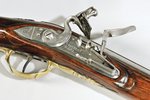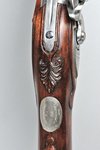


Years ago, I bought my first reproduction flintlock, a Japanese-made Miroku copy of a British Pattern 1769 musket. Back in the 1970s there were two decent models of reproduction muskets you could purchase. Japanese and Italian made copies of the British 1769 and the French Model 1763/66 muskets. They are quality arms and good shooters, but I wanted examples of other arms and done more closely to the originals. I knew there were some good contemporary makers out there but at the time I didn’t really have the money to afford one.
There are really nice kits available from The Rifle Shoppe, an Oklahoma-based company that sells a variety of parts for building early arms. When I was in my late 30s, I purchased my first kit, a British Pattern 1756 Long Land musket. After taking it out of the box I laid it all out to get started with the assembly. I soon realized that building the gun was way over my skill level and I tried to find someone with the skills to do the assembly work. I turned to Richard Colton, an arms historian and extremely skilled craftsman. After about a year it was completed, and I picked up this beautiful musket. Not only was it faithful to the originals, it was an excellent shooter! Soon I was buying more kits, having Rich and a few other talented makers building them, and buying others that I wanted to complete my collection. As much as I love the original arms of the American Revolution, shooting the originals isn’t something I like to do. The guns I am purchasing I consider functional art. While they look great hanging on the wall, they can be safely fired for fun as well as for historical research.
Although it has taken some time, I now have 13 custom-built flintlocks that we have been using to better understand the arms used during the Revolutionary War. From British Land Pattern muskets, fowling pieces used by civilians for hunting as well as their militia service, French muskets, carbines, a wall gun, and a lone rifle. I’m a big fan of the smoothbore gun over the rifle but that’s just a personal preference.
We have now used these arms for two ballistics studies to share with archaeologists, historians, and arms collectors. It’s been a thrill to not only collect them, but to put them to good use that will hopefully add to the historical knowledge of how these weapons functioned during that turbulent time in our history.
Comments
No comments on this item Please log in to comment by clicking here